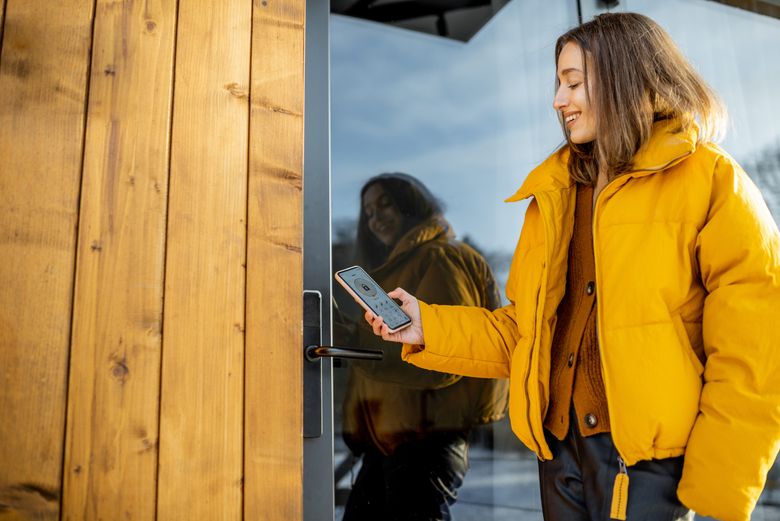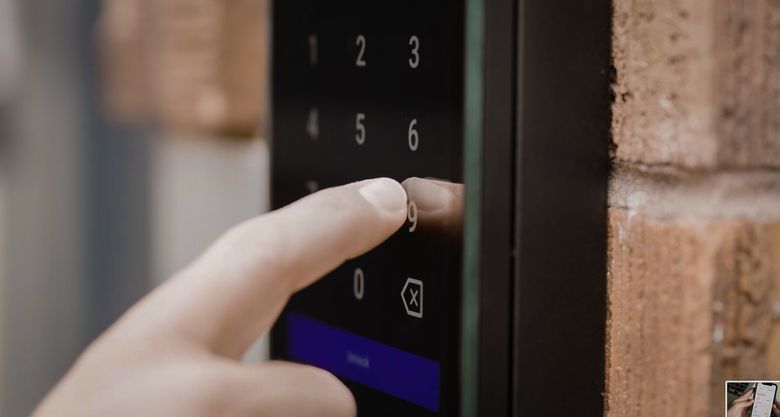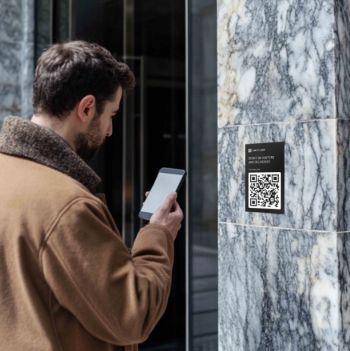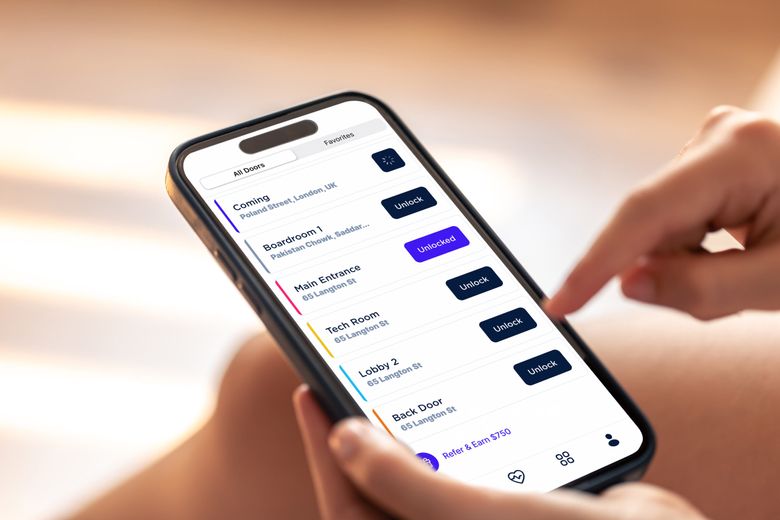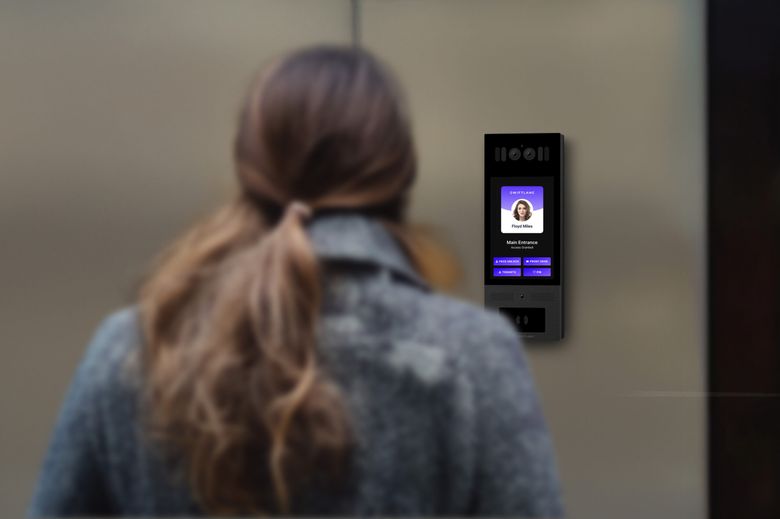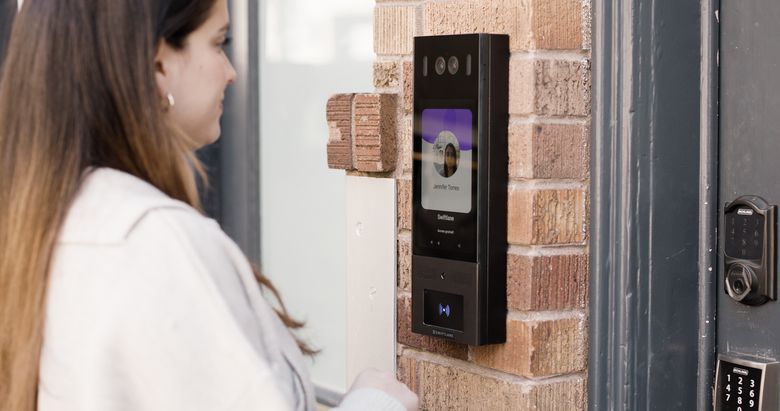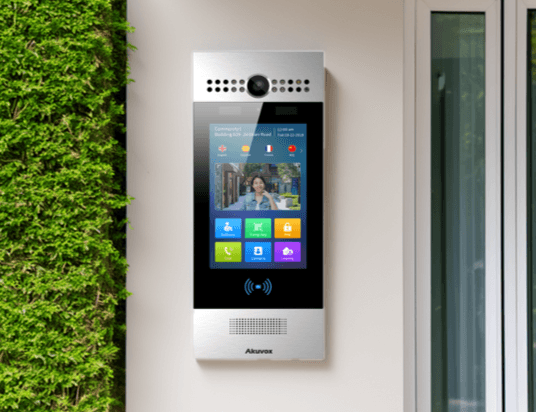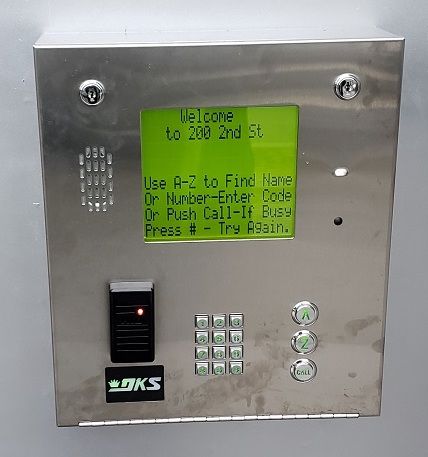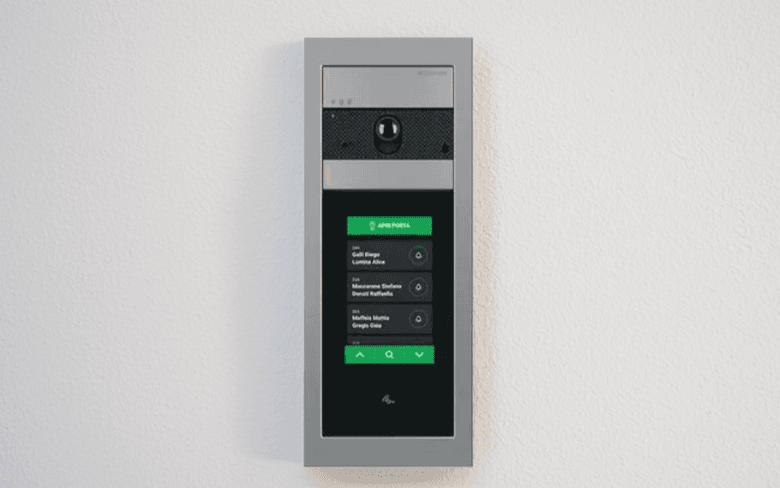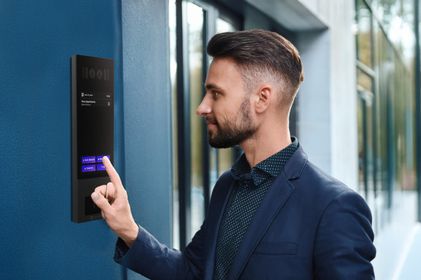In today’s fast-paced world, building owners and property managers want innovative solutions to enhance security, improve tenant convenience, and streamline operations. One of the most effective ways to achieve these goals is by adopting keyless entry systems.
With keyless access control, gone are the days of managing bulky keyrings, dealing with lost keys, or coordinating lock changes after tenant turnover. Keyless entry systems provide a sleek, secure, and highly efficient way to control access to properties, offering a host of benefits that extend beyond simple convenience. From boosting tenant satisfaction to reducing overhead costs and enhancing overall security, keyless technology is reshaping property management.
In this guide to keyless entry systems, we’ll explore the limitations of traditional metal keys and review how electronic keys like fobs and ID badges overcome some but not all of these drawbacks. Then, we’ll explore completely keyless forms of entry, including PIN codes and QR codes, mobile devices, and biometrics like facial recognition. We’ll explore how the different types of keyless entry systems help enhance security and provide operating efficiencies.
Table of Contents
- What is an Apartment Keyless Entry System?
- Traditional and Electronic Keys Have Limitations
- Types of Keyless Entry
- Types of Entry Points in an Apartment Building for Keyless Access
- Top Manufacturers for Keyless Entry Intercoms
- Key Considerations for Keyless Entry
- Why Choose Keyless Access Systems
- Frequently Asked Questions about Keyless Entry Systems
- Consider Swiftlane for Your Keyless Entry System
What is an Apartment Keyless Entry System?
A keyless entry system for apartments is an electronic access control system that allows residents to enter their apartments or buildings without carrying a physical key – either a metal key or an electronic key fob. Instead, residents can gain access using a code, their mobile device, or a biometric identifier such as face recognition access. Keyless entry is an option for individual apartment units, the building’s main entrance, elevators or garage access. You can also use them for common-use building doors to amenities like a gym or common room.
Traditional and Electronic Keys Have Limitations
You might think traditional key and lock systems are tried and true, but they have limitations.
- A new tenant moves in, and you must make them a new copy of the door keys.
- A tenant forgets their keys and needs help from property management to get in.
- A tenant’s key gets lost or stolen, and now you have to send a locksmith to put in new locks, potentially issuing new keys to every resident.
- Tenants may make and distribute copies of building keys, weakening your building’s security.
- Tenants usually need separate keys for the front door, common area doors, and apartment units, which become a hassle to sort.
- Building staff may need to carry dozens of keys.
Newer electronic forms of physical keys, like RFID key fobs and ID badges, solve some of these problems. You can remotely deactivate them when someone moves out, or program one fob to open multiple doors. However, most types of electronic keys can also be copied, or “cloned” without authorization. Each electronic key also costs more than a traditional metal key.
Meanwhile, with both traditional keys and electronic keys, each tenant has to carry something extra around. Younger generations are increasingly less likely to have car keys or carry wallets. This forces residents to use key cards or fobs. Traditional keys may be seen as old-fashioned and cumbersome. Keyless entry is a sought-after convenience of today’s modern buildings.
Types of Keyless Entry
A key benefit of keyless entry is that residents don’t have to carry around anything “extra” – they use their existing mobile device, biometrics, a PIN number, or the like, to identify themselves and get access. Using any of these means typically releases an electronic or magnetic door lock when the keyless entry system recognizes the authorized tenant or it triggers a gate or garage door to open in the case of vehicle entry.
Numeric PIN keypads
Numeric PIN pads, built into garage gates and front door intercoms were one of the first and most ubiquitous forms of keyless entry. They’re simple and rely on just 12 buttons. Newer systems, such as those built into video intercoms, may use a touchscreen instead of ordinary buttons. Building management can issue a numeric code that will open the door. With many systems, management can assign a different PIN number to each tenant, including temporary PINs for visitors that expire after use or a set time. Type in the right codes and the door or gate opens. Here are a few drawbacks: PINs can be shared, they can “leak” to unauthorized users, or they can be forgotten by the resident.
QR Codes
QR codes have become a popular form of keyless entry for systems entry systems like video intercoms with built-in cameras, usually to provide entry for visitors. A property manager or tenant issues a unique QR code to visitors through an app, email, or SMS message. You can create these QR codes to be time-limited, single-use, or recurring, depending on the access policy. The visitor displays the QR code in front of the camera at the entry point; it is recognized, and the door is released.
Mobile Access Control
Mobile devices, including smartphones and smartwatches, have become ubiquitous. With NFC or Bluetooth technology built-in – the same kind you use for “tap to pay” – many individuals are content to forgo carrying a wallet and keys and use their phone or watch as the “key” to their building. You just tap the device at an NFC or Bluetooth reader at the door, and it opens. Another form of mobile integration is to use a specific app on the phone to open doors and gates. Many intercom and access control hardware manufacturers offer such apps through a cloud-based platform.
Voice Activation
Some access control manufacturers offer a smartphone app that can work with Siri or other voice-enabled digital assistants. That way, you can say commands like “Siri, open the garage” or “Siri, unlock the door,” and the command will get routed through your app to an access control device like a front door intercom or parking gate.
Biometrics
Biometric access control uses the unique features of each tenant’s anatomy as the key to providing access.
- In ultra-high security systems, an iris scanner can check the unique pattern of each person’s eyes to grant or deny access.
- Fingerprint scanners are slightly more common, but interest in touch-free forms of access control grew after the COVID-19 pandemic.
- Facial recognition access control offers an increasingly popular form of hands-free biometrics. The tenant simply looks at an intercom camera, their face is recognized by the system, and the door unlocks, the same way many people unlock their phones by looking at them.
Unlike PIN and QR codes or mobile devices, which can be shared or used by unauthorized individuals, biometric access control can only be used by authorized people who have been entered into the system’s database. In that sense, they provide an extra layer of security.
Types of Entry Points in an Apartment Building for Keyless Access
While choosing keyless entry options, it’s important to consider all the access points inside a building. You can retrofit any of these entry points with a keyless entry system.
Apartment Unit Doors
This is the primary entrance to an individual’s apartment and is typically protected by a lock. The most common type of keyless entry for individual apartment units is PIN code typed on a keypad built into the door. These electronic locks can also include an NFC proximity reader, as is commonly used at hotels, which can detect a nearby mobile device as another way of gaining entry. Metal keys can often be used as a backup in these systems.
Common Building Doors
These are the main doors that provide entry to the building’s common areas, such as the lobby, hallway, and stairways, as well as various amenities a building may offer. Buildings can use keyless entry through PIN codes or mobile devices, especially for internal doorways. A building’s main door is usually outfitted with some kind of intercom, which can offer the full range of keyless entry options, including biometrics like facial recognition through a video intercom camera.
Vehicle Entry Gates
These are building gates that control access to the building’s parking areas and garages. Drivers can gain entry using a keypad reader located at the gates. Newer systems integrate with a smartphone app and driver technology like Apple’s CarPlay. That way, you can open the gates with voice commands while inside your car.
Elevators
Modern, luxury, and high-rise buildings may want to control who can access individual floors of the building, which is the reason for elevator access control. You can even integrate your building’s front entrance intercom with elevators. That way, elevator access can be preauthorized when a person arrives at the building.
Top Manufacturers for Keyless Entry Intercoms
Keyless Entry With Facial Recognition: Swiftlane Swiftreader X
In 2017, Apple wowed the world by introducing Face ID on its smartphones. Facial recognition is now available for keyless building entry systems and is packaged brilliantly into the Swiftlane Swiftreader X building intercom system.
- Product Overview: The Swiftreader X offers a highly durable intercom with 2-way video and a large full-color screen. Swiftlane intercoms all feature high-speed, hands-free facial recognition.
- Key Features:
- 720p video camera
- Large 8” full-color touchscreen provides 2-way video calls
- Built-in HID reader for card and keyfob access
- Also works with Siri voice activation, mobile devices, and QR Codes
- IP65 and IK10 ratings – top anti-vandalism rating great for outdoor use
- Mobile access control via personal device apps
- Power over Ethernet (PoE) connectivity
- Two-year limited warranty and 24/7 technical support
Keyless Entry With Fingerprint: Akuvox R29CT
Fingerprint access control offers buildings a secure biometric form of identification in which, unlock PIN codes, QR codes, or mobile devices, the “key” cannot be used by unauthorized person. High-security residences or commercial spaces sometimes seek this James-Bond-like level of security.
- Product Overview: The Akuvox R29CT intercom offers the unique capability of fingerprint biometric access control, which is not common to most standalone intercom systems.
- Key Features:
- Camera with up to 1920×1080 video resolution
- Time-stamped log of entries for security auditing
- Built-in fingerprint reader for fingerprint access control
- Also offers facial recognition, PIN entry, and keyfob/ID card, and one-time QR codes.
- Intercom features a built-in voice that provides instructions to users
- IP65 weatherproof
- Mobile app for remote access control.
Keyless Entry With Pin Code: Doorking 1837-90 Series Entry System
The original form of keyless entry, PIN codes, remains the old reliable standard. Doorking excels at manufacturing telephone call boxes with a standard pushbutton numeric keypad housed in a durable steel encasing.
- Product Overview: The 1837-90 Series is Doorking’s flagship series of telephone call boxes for multiunit buildings. The 90 features a scrollable digital directory that can host thousands of tenant names. You can program the system with 3,000 unique PINs that will unlock the door.
- Key Features:
- Audio-only call box system
- Can connect via plain old telephone service (POTS), Cellular, or VoIP connections.
- Single-color LCD directory screen
- Also offers key fob/ID card reader built in.
- Very durable metal housing withstands the elements.
Mobile Device Keyless Entry: Comelit Ultra
Mobile device entry has become a popular tool to replace ordinary keys. You simply tap your device to a proximity reader on the intercom to unlock the door. Comelit goes a step further by offering one-time QR codes that tenants can send to visitors’ smartphones. Just flash the QR code in front of the intercom camera and the door unlocks.
- Product Overview: The Comelit Ultra gets kudos for being a fully modular keyless entry system – you can choose different components, for instance, an ordinary pushbutton panel or a sleek glass touchscreen panel, depending on your building needs. While NFC and HID readers can integrate with smartphones, the camera can also detect QR codes for one-time visitor entry.
- Key Features:
- Modular components let you design your own intercom.
- Renowned for sleek Italian design.
- Optional touchcreen panels or traditional buttons for smaller buildings.
- 2MP camera for video calls and QR code reading
- Easily integrates with elevators and third party cameras
Key Considerations for Keyless Entry
Keyless Systems Can Easily Scale
One limitation of most traditional lock and key systems is everyone has to be issued the same front door key (which can lead to even more copies being made for the same key). With systems that use PIN codes, mobile apps, facial integration and the like, they can scale to thousands of unique users who each get their own unique access. You can seamlessly revoke singular access when tenants move out, without forcing everyone to change their key.
Keyless Systems Can Keep a Digital Record
With a traditional key, there is no record of who came in and out of the building or even data on basic volumes of foot traffic. Most modern keyless systems keep a digital record of who enters and exits. This can help enhance security. When a keyless system includes video, as required by facial recognition entry systems, there is even a visual record that can be used to help deter theft.
Convenient Cloud-Based Management
Many keyless access control systems connect to the Internet today. These so called smart-entry systems allow the manufacturer to offer a management platform located on the cloud. That means that updates to the system can be conducted remotely, such as from a central management office, without sending building staff to program each door. With many keyless systems that use cloud-based management, new residents can enroll themselves via an online portal or app, saving property management valuable time enrolling residents.
Keyless System with Intercom
Many keyless entry systems are paired with an intercom that visitors can use to request access from each tenant. These combined intercom and entry systems help buildings manage the high volume of delivery people and service workers attending to modern multiunit residential buildings. With an integrated intercom access control system, especially one with video, tenants can keep track of who requests access and see who is at the door. This helps deter both unwanted solicitations and porch piracy.
Wireless vs Wired Keyless Locks
When it comes to keyless entry for individual apartment units, the choice between wireless and wired locks can greatly impact the cost and ease of installation. Unit doors may require a wireless lock since cabling can be expensive to retrofit or install. However, common area doors like building entry doors, which are used frequently, may require a wired system to avoid changing batteries regularly.
Replacing Fobs with Modern Keyless Entry Options
Fobs are commonly used for building access control but can be an operational burden for landlords as they require someone to hand out the fob in person and revoke it. To reduce operational costs and manage properties remotely, landlords are exploring keyless entry options to replace traditional fobs. By offering multiple options, residents can choose the method that suits them best, reducing the likelihood of upset or alienation.
Why Choose Keyless Access Systems
By now, we hope you have gleaned the potential benefits of various forms of keyless entry. As a final overview, we share our top reasons for adopting keyless entry at residential buildings:
- No more lockouts due to forgetting keys
- No need to worry about copying keys for each member
- Easily change PINs over time to maintain security
- Give temporary access to visitors
- Better audit trail for door access to your apartment
- Easy to use your phone instead of always having to worry about carrying keys
- Touchless entry, such as face recognition or voice activation is available
- Remotely unlock doors for visitors even when you are not home
- Continue to use a traditional key as a fallback or alternative option
Frequently Asked Questions about Keyless Entry Systems
How to install keyless entry system?
Unwired, battery-powered keyless locks, the kind often used at individual apartment unit doors, can usually be installed by a competent maintenance person or knowledgeable do-it-yourselfer. YouTube often features how-to videos for the most popular products.
Keyless entry systems that require a wired power source or have multiple components, such as a door strike mechanism connected to a building intercom, must typically be installed by a trained professional with electrical skills. This is typical of a front door system of a multi-unit building, vehicle gates, and other wired entry points. Your hardware manufacturer can often provide a list of recommended security services and installation providers in your market.
How much does a keyless entry system cost?
The price of keyless entry systems ranges based on the type of hardware and the use case. Smart door locks with PIN pads for individual apartment doors typically range between $250 and $500. For the building’s main door, keyless entry is usually built into the building’s call box or intercom system. The most basic systems for apartments with just 4 units can be found for just under $1,000. Advanced systems for larger multi-family buildings range from $1,000 to $5,000 for the hardware
Price is not always correlated with the best systems or the most features. You can find keyless video intercom systems with built-in facial-recognition and full-color touchscreens for under the $3,000 price point, while some old-fashioned audio-only call boxes cost over $4,000.
What is the difference between keyless entry and smart entry?
The terms keyless entry and smart entry are often used interchangeably, but they refer to slightly different concepts within the realm of modern access control systems. Keyless entry refers to any system that allows access without using a traditional physical key. This can include a variety of methods, such as keypads and biometrics. Smart entry is a subset of keyless entry systems that use internet-connected technology to offer advanced features and control. Smart entry systems are part of the broader “smart home” or “smart building” ecosystem.
Consider Swiftlane for Your Keyless Entry System
Swiftlane offers building intercoms and access control systems with keyless entry as a standard feature. Our systems provide options for PIN codes, QR codes, voice entry, legacy RFID key fobs, and our hallmark feature, facial recognition.
Contact Swiftlane for a Quote and Consultation
Contact us for a free quote of our keyless entry system for apartments

